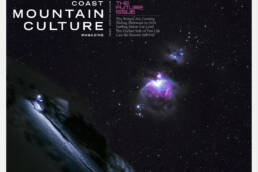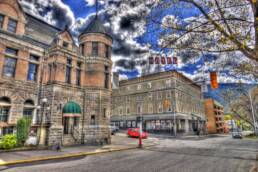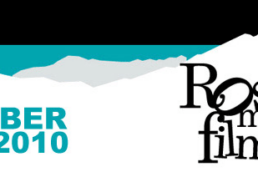The latest cover of Coast Mountain Culture magazine features an other-worldly ski photograph by Reuben Krabbe. Here we interview him about how it all came together and the movie that details it’s creation.
My favourite line from Reuben Krabbe’s new 12-minute film Nebula dropping this week, is uttered by skier Nick McNutt. His facial hair and toque are caked in ice and his breath escapes in visible puffs of vapour as he looks at the display on the back of Krabbe’s camera and says, “Woah…skiing in space!” Yes. Exactly. That’s totally what it looks like.
For those who have seen the latest Coast Mountain Culture magazine cover, you may be forgiven in thinking the picture is a photoshop composite. It’s not. That image is the result of two years of planning by Krabbe, a professional shooter based in the Coast Mountains of British Columbia, along with some specialized equipment. It’s a double exposure that features the Orion Nebula, an interstellar cloud of dust, hydrogen, helium and other ionized gases, and skier McNutt hurtling down a backcountry slope near Pemberton. This is the third in a series of astro ski images by Krabbe that have included an athlete shredding a line under the aurora borealis and another perfectly framed by a solar eclipse. This latest image required a lot more planning and luck though, which is why Krabbe made a movie about the entire experience and it will launch November 6th at www.Nebula-Film.com. We caught up with Krabbe to ask him about the image and the film.
Hey Reuben, congrats again on such a sick image. There were so many challenges involved with this shoot. What was the biggest for you?
Honestly, motivation was the hardest part. After trying the get the shot the first time and failing so epically, it was really defeating. Looking at going back at it and doing the shoot again was hard. Especially because we burned through our sponsorship funding from MEC in the first year so our crew would have to pay for the rest and I was like, “Is this just going to be another grand ridiculous adventure?” I could screw up so easily and that’s what you see in the film – I’m screwing up throughout the night when we actually created the shot. If my placement was a little bit wrong, if I was 30 feet to the left, the whole thing would have failed again. The other thing that was challenging was the fact people didn’t exactly understand what the concept was leading up to it. Like, the athletes didn’t really get what we were trying to do. And I couldn’t really help them understand because the whole thing was so ridiculous and technical.
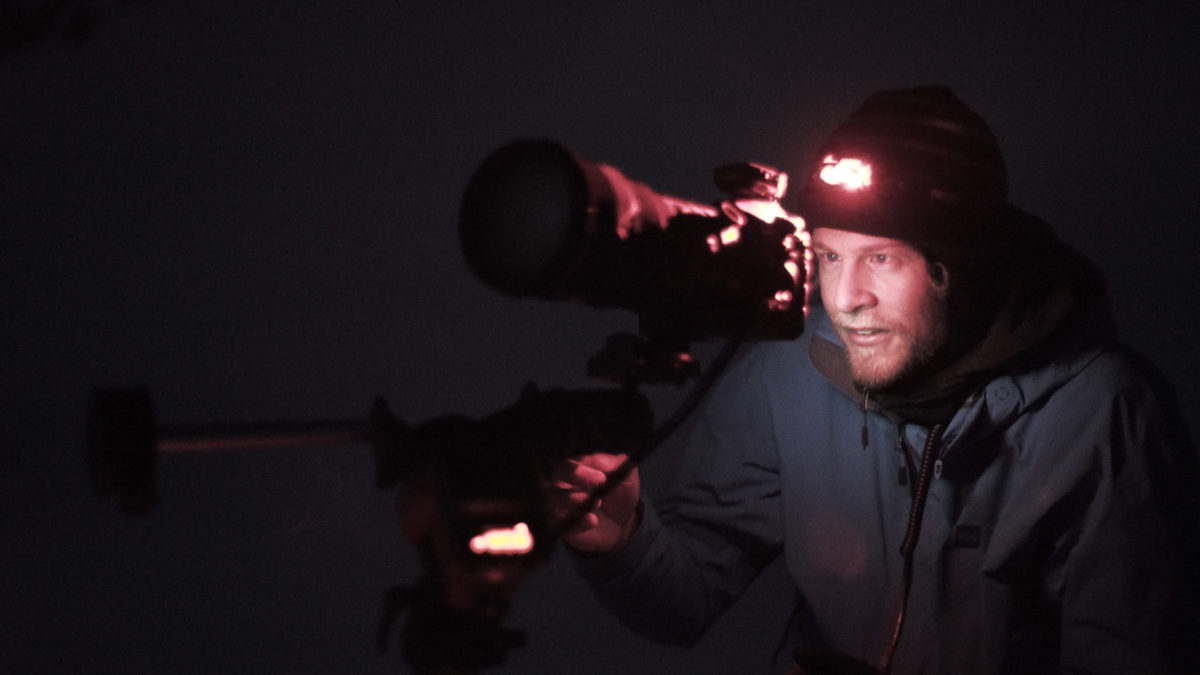
And everything was made that much more difficult because of the weather. What temperatures were you battling the night of the shoot?
I think it was around -20°C to -25°C out. It was one of the coldest nights of the year and unfortunately you don’t get clear skies on the coast unless you’re getting a northern outflow so that’s the only way it was going to happen.
Still, you managed to get the shot. At one point did you celebrate?
The moment in the movie where you see me say, “We got it guys,” that’s when I knew that we had it. It might not have been exactly what I dreamt of, but it was the best image we could create given the conditions and circumstances. But still, it was ridiculously cold and we were in the middle of nowhere and our toes were getting scary cold so the celebration wasn’t much, it was more of like, “OK, good we’re done. Let’s get out of here.” I think the celebration will come when we see that the effort was worth it and this film and the photo resonates with people. Until then, it’s just layers of relief interspersed with lots of work still.
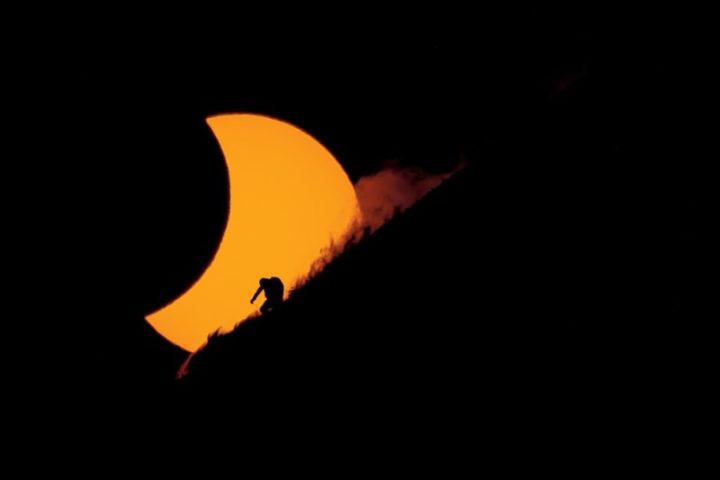
Where did this entire idea come from? Why did you want to shoot the Nebula?
This was definitely an evolution from the original Aurora photo I did followed by the eclipse shot. And those were inspired by the Grant Gunderson shot of the skier and the star trails in the sky. After the eclipse shot, I started having ideas of what this could be but I wasn’t sure I wanted to be pigeon-holed as the guy who keeps doing the same trick. But I do a bunch of other stuff so it’s not like a feel like I’m only doing one thing ever. I didn’t know at the beginning how it was going to be possible but I started by looking into whether I could hire one of those huge mountain-top telescopes to shoot an action photo. But that was like $10,000 an hour to use the thing and then you couldn’t shoot anything that’s below you. So then I figured out what’s going on in astro-photography and there’s a whole group of people who do this kind of stuff all the time – just shooting the stars I mean, with these long lenses and specialized equipment. I cobbled together the equipment and started trying to figure out how you can shoot an action photo and a star photo simultaneously.
What specific equipment was required for this?
The main thing is called an equatorial mount. It goes on top of the tripod and that thing counteracts the spinning of the earth. It makes your telescope lens for your camera point to the same point in the stars the whole time – it’s just ever-so-slightly in motion the entire time you’re using it in order to keep the stars in the centre of your camera’s frame. It’s a decently expensive thing but they’re also standardized. It’s not like I had to do all the tough work; you can just buy it off the shelf. The first time I tried using a cheaper version of that mount but there were a few logistical issues so I upgraded to a bigger and smarter version. Otherwise it’s a regular camera set up: it’s a 400mm lens on a DSLR that I use any day I’m on a shoot.
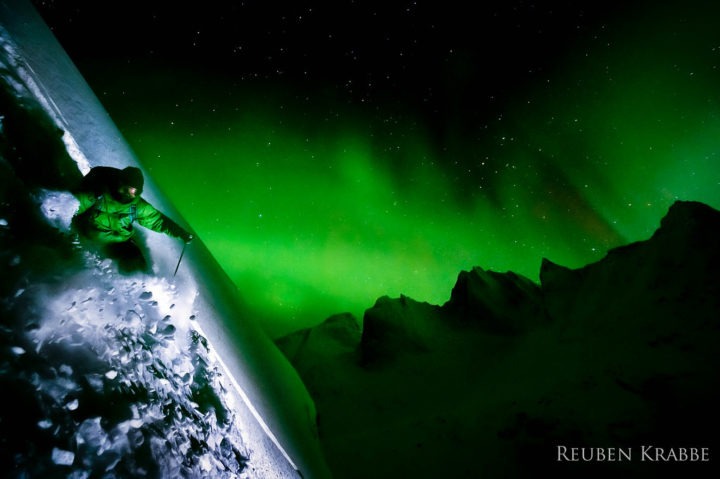
Are astro-photographers impressed by this capture?
I’m on the baby steps of astro-photography. Like, the first thing thing they tell you in astro-photography is to shoot the Orion Nebula. For ski bums, it may seem like I’m a photographer for NASA but among astro-photographers, I’m on the bunny hill. The Orion Nebula is roughly the size of the moon in the sky but it’s slightly darker for human eyes to see. To find it, look for Orion’s Belt then look just below it and there’s this little chain of three stars which looks sort of fuzzy, like it’s out of focus. That’s because you’re seeing a little bit of the background light that’s there but you can’t tell what you’re looking at because your eyes aren’t good enough.
Tell me a bit about your photo background?
I picked up a camera as a teenager in Calgary and then that turned into an expensive hobby. I decided that rather than go to school for some other education and thenchase my dream, I should try to chase it right away. So I went to photography school around 2008 and then moved into a van and spent some time moving around BC. I’ve been on the coast for eight years now.
My final question for you is what’s next?
[Laughs.] Yeah, that one’s going to be coming all the time. The two guys who made the movie with me, we’ve launched a production company called Sky Island Pictures in the wake of this film because we worked well together. We’ve been pitching different concepts for production. But on the non-work side of things, I’ve been trying to learn how to surf and I’ve come to appreciate that it’s fun to be super terrible at things.
Vince Hempsall
Vince Hempsall lives in the beautiful mountain town of Nelson, British Columbia, where he spends his time rock climbing, backcountry skiing and mountain biking (when not working). He is the editor of Kootenay Mountain Culture Magazine and online editor for the Mountain Culture Group.
Related Stories
Photographer David Marciano Wins Banff Mountain Film Festival Photo Essay Competition
The Banff Centre Mountain Film Festival has just announced the winner of the latest Photo Essay Competition is Italian…
New NFB David Suzuki Film
An inspiring footage highlighting and inspiring film about an inspiring guy. David Suzuki, our most visible…
Parallels – A Short Film
Parallels is a short film produced by Dendrite Studios in April of 2011. Created by: dendritestudios.com
Rossland Film Fest this Weekend
The Rossland Film Fest goes this weekend in, you guessed it, Rossland, where a recent winter storm has buried the…
b4apres Debut Film AZADI: Freedom
Anthony Bonello and his crew at b4apres media have just released the teaser to their new film, AZADI: Freedom. The film…


